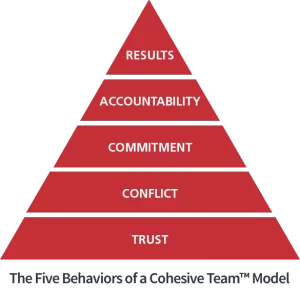Best Team Development
Team Development

 Solutions
Solutions
The Five Behaviors of a Cohesive Team, crafted by Patrick Lencioni, offers a comprehensive framework that outlines the critical principles needed for effective team operation. This model emphasizes five foundational behaviors: Trust, Conflict, Commitment, Accountability, and Results. These elements are pivotal in fostering synergy and driving teams towards their collective goals with efficiency.
Trust is identified as the cornerstone of a cohesive team. It is rooted in vulnerability-based trust, where team members are encouraged to openly express their ideas, acknowledge mistakes, and present their genuine selves without fear of judgment. Establishing this type of trust creates a supportive environment where all members feel valued and integral to the team’s fabric. Workshops designed to build trust help dismantle barriers, strengthening the team’s unity and collaborative spirit.
The model also highlights the importance of healthy conflict as a catalyst for growth and innovation. With a solid base of trust, teams are more inclined to engage in constructive, idea-focused debates rather than personal conflicts. This approach to conflict promotes better decision-making and creativity, keeping the team dynamic and forward-moving. Committing to decisions, even with incomplete information, is vital. The model ensures that after thorough discussion, every team member aligns and commits to the team’s decisions, facilitating concerted action towards achieving set objectives.
Finally, accountability and a focus on collective results are what truly define a cohesive team. Members hold each other accountable, maintaining a high standard of performance and adherence to team goals. Workshops emphasizing accountability foster a culture of mutual support and constructive feedback. The ultimate aim is to prioritize the team’s success over individual achievements, which enhances productivity and job satisfaction across the board. This holistic approach not only strengthens individual team units but also contributes positively to the broader organizational culture.

 Solutions
Solutions